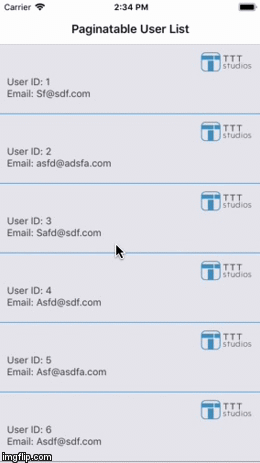PaginatableList is a list component developed by TTT Studios Mobile Team. The purpose is to avoid repetitive logic that handles "loading more" and "pull-to-refresh" actions in a list, via pagination using a REST API. PaginatableList is built on top of React Native's FlatList, but it's available to manage the list items automatically and store them in Redux store.
By default, it provides:
- Reaching the list bottom to load more items after making a GET API call.
- Pull-to-refresh the whole list.
- Store list items with Redux store.
However, the item cell appearance is customizable and more actions can be added, independently from the two default actions coming by default in the package.
- Install paginatable-list
yarn add @twotalltotems/paginatable-listornpm install @twotalltotems/paginatable-list --save - Install dependencies
yarn add redux && yarn add react-redux && yarn add redux-thunk && yarn add reduxsauce && yarn add axios && yarn add prop-typesornpm install redux && npm install react-redux && npm install redux-thunk && npm install reduxsauce && npm install axios && npm install prop-types
This project needs the follow dependencies inside your project.
reduxreact-reduxreduxsauceredux-thunkprop-typesaxios
In order to use PaginatableList, first create a PaginationStateManager instance. There are two required parameters:
import { PaginationStateManager } from '@twotalltotems/paginatable-list';
const BASE_URL = 'http://myapi.endpoint';
const onParseResponseData = (data) => {
// From the response, an array of items and total pages value are required to setup the manager
const { results, totalPages } = data
return {
items: results,
totalPagesNumber: totalPages
}
}
const paginationStateManager = new PaginationStateManager('users', `${BASE_URL}/users`, onParseResponseData);
| Parameter | Description |
|---|---|
| name | Redux store key that will be used to store list items. In this example, users is the key that will be used to store the item list in the Redux store. |
| endpointUrl | The paginatable endpoint URL for requesting content for each page with pageNumber and pageSize. In this example, ${BASE_URL}/users is the endpointUrl. |
| onParsePaginationResponse | Depends on the different structure of the API response, this method is required to parse list item out of the whole response data. This method needs to return a javascript object that contains key items which holds the array of items in the list. |
| customizedReducerPath | Optional. This paramter is required unless you'd like to embed pagination reducer into another reduer. Please refer Customization section for more details. |
| requestHeaders | Optional. Pass in this paramter if the pagination server needs HTTP headers. This parameter requires a Promise. |
import { combineReducers, applyMiddleware, compose, createStore } from 'redux';
import ReduxThunk from 'redux-thunk';
const getCombinedReducers = () => {
return combineReducers({
users : paginationStateManager.reducer(), // 'users' should be kept the same as the first param in PaginationStateManager instance created in the last step.
});
}
const reduxStore = createStore(
getCombinedReducers(),
{}, //Initial State of Redux Store
compose(
applyMiddleware(ReduxThunk)
)
)
Notice: The key used in combineReducers need to be consistant with the key that is used to initialize PaginationStateManager in the last step, which in this example, is users.
Inside your component, you can use this code. Don't forget to import PaginatableList at the top of the component first.
import PaginatableList from '@twotalltotems/paginatable-list';
render() {
return (
<View style={{ flex:1 }}>
<PaginatableList
onRenderItem={this.renderListItem}
customizedPaginationStateManager={paginationStateManager}
/>
</View>
)
}
renderListItem = ({ index, item }) => {
return (
<TouchableOpacity>
<Text>User ID:{item.id}</Text>
<Text>Email: {item.email}</Text>
</TouchableOpacity>
)
}
renderListItemis used to render a specific list item.PaginatableListexists as the scrollable container of the list items that will complete for you, the two package operations: loading more items and pull-to-refresh. With this in mind, you can use thisPaginatableListcontainer to holder whatever you prefer. It could beView,TouchableOpacity, or your customized component.- In this example,
renderListItemparamsitemis the object within the array that is stored in Redux store. Currently,PaginationStateManageris storing whatever the server response is. In this example, the local server is returning an array of objects, and each object containsid,email, andpassword. Therefore, Redux store is storing by default the exact same format of the object.
| Props | Description |
|---|---|
| customizedPaginationStateManager | Instance of PaginationStateManager that manager the items in the list. |
| onRenderItem | Render list item. |
| onRenderEmptyStatus | Render the empty status of the list when there's no items loaded in the list. |
| onRenderSeparator | Render separator of the list. |
| pageNumberKey | The key of page number in HTTP request. |
| pageSizeKey | The key of page size in HTTP request. |
| pageSize | Maximum amount of items that are returned in each request. |
| pageNumberStartFrom | Starting page of the list (by default it starts from 1). |
| onLoadMore | Overwrite list loading more items if you need to handle loadMore on your own. For examplem, you might need to query with more parmas than pageNumber and pageSize. |
| onRefresh | Overwrite list refreshing method if you need to handle refresh on your own. |
| onLoadError | Handle the loading error. |
If you want to set pageNumberStartFrom with 0, you would need to provide the proper totalPagesNumber in the onParseResponseData.
Besides, PaginatableList accepts props of FlatList that include numColumns, extraData, keyExtractor, style, and showsVerticalScrollIndicator.
If you need more than loading more items and pull-to-refresh, continue reading.
Defaultly, PaginatableList will only use pageSize and pageNumber as query parameters to make HTTP request to dynamically load more items and refresh the full list. However, if you need extra params, for example, you'd like to add keyword searching for the list, then the HTTP request will need extra param keyword. In this case, you need to overwrite onLoadMore and onRefresh for PaginatableList.
<PaginatableList
onRenderItem={this.renderListItem}
customizedPaginationStateManager={paginationStateManager}
onLoadMore={this.onLoadMore}
onRefresh={this.onRefresh}
/>
// If you are using version < 0.3
onLoadMore = ({ onCompleteLoadMore, ...args }) => {
this.props.dispatch(paginationStateManager.loadMore({
...args,
keyword: 'keyword'
}))
}
onRefresh = ({onCompleteRefreshing, ...args}) => {
this.props.dispatch(paginationStateManager.refresh({
...args,
keyword: 'keyword'
}, (data) => {
onCompleteRefreshing(data)
}))
}
// If you are using version >= 0.3
onLoadMore = ({ ...args }, onCompleteLoadMore, onLoadError) => {
this.props.dispatch(paginationStateManager.loadMore({
...args,
keyword: 'keyword'
}, onCompleteLoadMore, onLoadError))
}
onRefresh = ({...args}, onCompleteRefreshing, onLoadError) => {
this.props.dispatch(paginationStateManager.refresh({
...args,
keyword: 'keyword'
}, onCompleteRefreshing, onLoadError))
}
If you have dynamic segments in the endpoint url, for example, /user/:user_id. Use setEndpointUrl method of PaginationStateManager to overwrite the endpoint Url before passing the PaginationStateManager instance to PaginatableList.
const BASE_URL = 'http://myapi.endpoint';
const userId = 1;
componentWillMount() {
paginationStateManager.setEndpointUrl(`${BASE_URL}/users/${userId}`)
}
For many lists in real life situations, you would need more than only two common operations for the list. Example for an extra operation could be click a heart icon to like an item, delete an item, or highlight an item. Below there's an explanation for the highlighting example.
To customize, first subclass from PaginatableListReducer.
import { PaginationStateManager } from '@twotalltotems/paginatable-list';
export default class CustomizedPaginationStateManager extends PaginationStateManager {
constructor(name, endpointUrl, onParsePaginationResponse, customizedReducerPath = null) {
super(name, endpointUrl, onParsePaginationResponse, customizedReducerPath)
}
}
Initialize instance of CustomizedPaginationStateManager, and add extra action to it.
const onParsePaginationData = (data) => {
const { results } = data
return {
items: results
}
}
export const customizedPaginationStateManager = new CustomizedPaginationStateManager('customized_users', 'users', onParsePaginationData)
customizedPaginationStateManager.addActions([
{
type: 'highlightItem',
payload: ['index'],
handler: (state, { index }) => {
return {
...state,
highlightedItemIndex: index
}
}
}
])
First, let's make the list item clickable, and make it call onHighlightItem when the item is clicked.
renderListItem = ({ index, item }) => {
return (
<TouchableOpacity
onPress={() => {
this.onHighlightItem(index)
}}
>
<Text>User ID:{item.id}</Text>
<Text>Email: {item.email}</Text>
</TouchableOpacity>
)
}
onHighlightItem = (index) => {
this.props.dispatch(customizedPaginationStateManager.highlightItem({ index: index }))
}
render() {
return (
<UserListComponent
paginatableListReducer={customizedPaginationStateManager}
onHighlightItem={this.onHighlightItem}
/>
)
}
Whenever you add extra actions to the subclass instance of PaginationStateManager, this library will generate a default handler for you which will dispatch the action directly. However, if you would like to do more before dispatching the action (e.g. make an API call), you can overwrite the default handler.
import { PaginationStateManager } from '@twotalltotems/paginatable-list';
export default class CustomizedPaginationStateManager extends PaginationStateManager {
constructor(name, url) {
super(name, url)
}
highlightItem = ({ index, extra }) => {
console.log('Overwrite Default highlightItem() function. For example, you might need to do network call before dispatch an action.')
// This is where you could add the API call.
return (dispatch) => {
dispatch(this.actions.highlightItem(index, extra))
}
};
}
When accessing a paginatable endpoint that requires HTTP headers, we need to pass in the requestHeader parameter in the constructor of PaginationStateManager. For example, the endpoint needs a token from the headers to access.
const getRequestHeaders = async() => {
const token = await AsyncStorage.getItem('TOKEN')
if (token) {
const headers = {
Accept : 'application/json',
Authorization : `Bearer ${token}`
}
return headers
}
return {
Accept : 'application/json'
}
}
const paginationStateManager = new PaginationStateManager('users', `${BASE_URL}/users`, onParseResponseData, 'users', getRequestHeaders );
Customize empty status for PaginatableList via onRenderEmptyStatus props.
renderEmptyStatus = () => {
return (
<View style={{ flex:1, alignItems: 'center', justifyContent: 'center' }}>
<View>
<Image
style={style.emptyStatusLogo}
resizeMode={'contain'}
source={require('path/to/image.png')}
/>
<Text>Customized Empty Status</Text>
</View>
</View>
)
}
render() {
return (
<View style={{ flex:1 }}>
<PaginatableList
onRenderItem={this.renderListItem}
onRenderEmptyStatus={this.renderEmptyStatus}
customizedPaginationStateManager={this.props.paginatableListReducer}
/>
</View>
)
}
If you need to manually trigger a list refreshing without pulling down the top of the list. First use onRef props to create a reference of PaginatableList instance that you'd like to refresh manually.
<PaginatableList onRef={(ref) => this.paginatableList = ref} />
Then calling this.paginatableList.onRefresh(false) will present a manual list refreshing without refresh control.
<TouchableOpacity onPress={() => {
if (this.paginatableList) {
this.paginatableList.onRefresh(false)
}
}}>
By default, parameter customizedReducerPath is not required, and the name paramter will be used as the key to store the list items in the Redux store. However, if you'd like to embed pagination reducer into another reducer.
For exmaple, if we use a paginatale list to load students of a certain teacher. Teacher is already stored in the Redux store, and we need to store the students in the same object with teacher. So we'd like the app state stored in Redux store looks like the javacript object below.
{
teacher: {
students: {
items: ['student 1', 'student 2', 'student 3']
}
}
}
In this case, we need to pass 'teacher.students' as the customizedReducerPath parameter, and the name parameter will not be used as the key of paginatable reducer anymore.
const reduxStore = createStore(
combineReducers({
teacher: combineReducers({
students : paginationStateManager.reducer()
})
}),
{}, //Initial State of Redux Store
compose(
applyMiddleware(ReduxThunk)
),
)
- Customizable list empty status and list separator.
- Customizable HTTP headers and HTTP response parsing.
- Remove
reduxsaucedependency. - Remove Redux as a dependency.
|
Felipe Peña |
Vinson Li |
Anson Yao |
Gokul Kumar |
Felix Cheng |
Mitchell Ganton |
Gordan Zhang |
|---|
Paginatable List is presented by the mobile team at TTT Studios. We are a Digital Innovation Studio based out of Vancouver, Canada, delivering custom software and solutions that are designed and developed 100% in-house. The technologies we work with include AR & VR, IoT, AI, security & encryption, and cloud computing.


